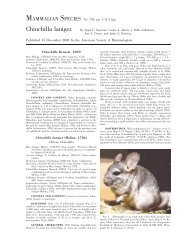Brugia Malayi - Clark Science Center - Smith College
Brugia Malayi - Clark Science Center - Smith College
Brugia Malayi - Clark Science Center - Smith College
You also want an ePaper? Increase the reach of your titles
YUMPU automatically turns print PDFs into web optimized ePapers that Google loves.
Pragmatics in Children with High Functioning Autism Spectrum Disorders<br />
Jacqueline Baron<br />
As a continuation of the work done regarding language pragmatics in children with Autism Spectrum Disorders (ASD),<br />
particularly that currently being conducted by Peter de Villiers, we examined videos of young children with high functioning<br />
ASD for elements of their social use of language, particularly regarding contingency, or relevance of speech to the conversation,<br />
with the goal of one day creating a pragmatics assessment for children with ASD. We transcribed videos of children between<br />
the ages of 3;11 and 7;11 who have been diagnosed with an ASD but demonstrate no significant language delay interacting oneon-one<br />
with a parent in a room with toys and other materials. Several of these children were filmed again a year later, and we<br />
began transcribing those videos as well. At the time, or times, when they were filmed, the children were tested on oral language<br />
expression, language comprehension, verbal IQ, and nonverbal IQ.<br />
Though we are still in the process of transcribing the videos, once that is complete we will analyze the transcripts of these<br />
interactions on several dimensions. First, we will code each transcript using the Index of Productive Syntax, or IPSyn. The IPSyn<br />
looks at the frequency with which 56 different linguistic forms of varying complexity are used in a given speech sample. It looks<br />
at four categories of forms: nouns, verbs, questions and negations, and sentence structure. Additionally, we will be examining the<br />
children’s contingency in their conversational speech—that is, whether or not things the child says directly relates to what was said<br />
immediately before—using the coding scheme developed by Tager-Flusberg and Anderson. 1<br />
As we have not yet reached the point of coding or analyzing data, it is difficult to draw conclusions at this time. Through this<br />
research, however, we hope to gain a better understanding of what factors are related to conversational contingency in children<br />
with ASD. We will look at possible relationships between conversational contingency and IPSyn scores, oral language expression<br />
scores, language comprehension scores, and verbal and nonverbal IQ scores. Ultimately, these results will give us a clearer picture<br />
of the significance of conversational contingency and the deficits that lie therein for children with high-functioning autism. What<br />
we have accomplished so far has been shared with students from Wesleyan University, Wellesley <strong>College</strong>, and Barnard <strong>College</strong> at<br />
an informal developmental psychology conference at Wesleyan University. (Supported by the Frances Baker Holmes Fund)<br />
Advisor: Peter de Villiers<br />
References:<br />
1<br />
Tager-Flusberg, H. & Anderson, M. 1991. The development of contingent discourse ability in autistic children. Journal of Child Psychology and Psychiatry, 32:<br />
1123-34.<br />
2012<br />
160

















